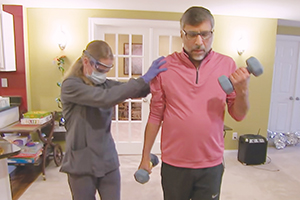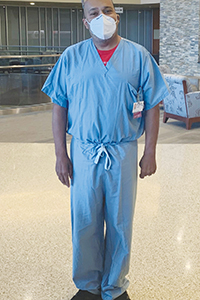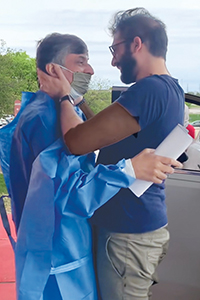By LISA EISENHAUER
Dr. Nadeem Qureshi was exhausted. He'd just returned from teaching overseas and figured he needed a couple of days of rest to shake off the jet lag. As that next week of late March 2020 progressed, the fatigue lingered, a mild fever set in and his sense of taste diminished.

Dr. Nadeem Qureshi, an emergency physician at SSM Health Cardinal Glennon Children's Hospital in St. Louis, works with physical therapist Jill Roesch at his home in suburban St. Louis. Qureshi spent weeks in the hospital in spring 2020 fighting COVID-19 and is still overcoming lingering effects. His story is among those featured in "Behind the Mask," a documentary that SSM Health produced about workers on the front line of the pandemic.
A pediatric emergency medicine physician at SSM Health Cardinal Glennon Children's Hospital in St. Louis, Qureshi was aware that the World Health Organization had just declared COVID-19, the illness being spread by the novel coronavirus, a pandemic. One of the stopovers in his travels had been in Spain, already a hotspot for the virus.
Nevertheless, as a healthy 55-year-old who'd never spent a day hospitalized, he expected that even if he'd contracted the virus, after a week or two of rest and quarantine, he'd be back on his feet.
Instead, his bout with the virus resulted in a weeks-long hospital stay, much of it attached to a ventilator or extracorporeal membrane oxygenation machine.
"It's been a long, challenging road," says Qureshi, who a year and a half later continues to recover from effects of the virus.
No one is tracking the number of health care workers who have contracted the virus amid the ongoing pandemic, but a joint investigation by The Guardian and Kaiser Health News found that during its first year at least 3,600 U.S. medical workers died of COVID-19.

Pyun
Qureshi considers his bout a brush with death. Octave LeDuff, a patient care technician at St. Joseph Mercy Oakland in Michigan, also considers himself fortunate to have survived after spending 71 days hospitalized with COVID complications. Another COVID patient, Dr. Edward Pyun, trauma medical director for Good Samaritan Medical Center in Lafayette, Colorado, endured a tough, though not life-threatening, ordeal with several days in the hospital.
All three say they came away from the experience with more compassion for patients.
From dehydration to intubation
It was two other ER doctors — one his son and the other a good friend — who convinced Qureshi after several days of illness to go to the hospital to at least get treatment for dehydration.
He remembers the ambulance crew tried to convince him to stay home because he was strong enough to walk to the door to greet them and his symptoms seemed fairly mild. They warned him that he was risking exposure to the virus if he didn't have it. He, his son and his friend prevailed.
At the hospital, tests showed that Qureshi's oxygen saturation level was dangerously low. The doctors told him: "You're not going to be going home." They put him on hydration fluids and sent him to the intensive care unit for observation. Within six hours, as his condition deteriorated, Qureshi was intubated.
Too early for conventional therapy
He has little memory of the few weeks that followed. He was on a ventilator, and when his vital signs indicated that his heart and lungs were overwhelmed, he was hooked up to extracorporeal membrane oxygenation. He also suffered kidney failure, stroke and inflammatory response syndrome with markers that his doctors told him were off the charts.

Octave LeDuff, a patient care technician at St. Joseph Mercy Oakland in Michigan, says that with outside visitors prohibited, visits from his colleagues helped him endure more than two months of hospitalization for COVID-19.
It was so early in the pandemic, there was no conventional therapy. His doctors at an academic medical center consulted with peers across the country about treatment options. Among the therapies they tried was a monoclonal antibody drug, a treatment that the Food and Drug Administration has since given emergency approval for use in mild to moderate COVID cases.
After about 21 days in the ICU Qureshi was able to breathe without machines. He's still unsure of how he survived. "In a nutshell, they call me a miracle survivor, having multiple organs fail, the mortality was about 98, 99%," Qureshi says.
Slowly recovering
His hospital stay was followed by two weeks at an inpatient rehab center rebuilding his strength to walk and perform other basic activities. He then returned to his home in suburban St. Louis, where he continued to get care from visiting nurses and therapists for several months.

Dr. Nadeem Qureshi is greeted by his son, Dr. Moiz Qureshi, as he leaves the hospital after a near-fatal bout of COVID-19. Both men are emergency physicians. Because of COVID protocols, they had only been able to see each other by video for weeks.
Late this summer, Qureshi was easing his way back to work, starting with resuming some online teaching. In time, when he is able to return to his job as an ER doctor, he knows he will demonstrate a strengthened commitment to compassionate care.
"I was in a very difficult situation," he recalls of his acute illness. "And at that point, each and every person who extended their support to do something a little extra to what their required response already was, it went a long way. It meant a lot to me."
When he chats with his caregivers or speaks on professional panels at symposiums, he urges clinicians to make those little extra efforts — asking patients if they need a drink of water, a readjustment in their bed, an extra blanket — a regular part of their rounds.
"The medical care should not be limited, in my opinion, to just the medicine, imaging, lab test aspect," Qureshi says. "The patient should be treated in a holistic manner, and his physiological needs should be addressed. They are our responsibility."
In the care of colleagues
LeDuff, 53, says one of the things that rallied him during his long hospitalization with COVID was visits and encouragement from his colleagues. His career at St. Joseph Mercy Oakland spans 25 years.
"I was so glad that I was at the hospital where I worked because at that time you couldn't have visitors," he recalls. "I couldn't have my kids, my wife, nobody come in. To see people that you know in the workplace made it much better. It made the ride much easier."
LeDuff's illness began with a fever in November 2020. When his temperature spiked to 102, his wife persuaded him that an ambulance should be called. En route to the hospital, he began struggling to breathe. At the hospital, he was put on a continuous positive airway pressure, or CPAP, machine to force more air into his lungs.
When that didn't raise the dangerously low level of oxygen in his blood, doctors sent LeDuff to the ICU. He spent a week on a ventilator before recovering enough lung capacity to breathe on his own. Still gravely ill, he was moved to a step-down COVID unit, where he remained for two months. Before he was released from the hospital in January, he says he needed rehab to relearn how to walk and feed himself.
"I thank God that he let me pull through that situation," LeDuff says.
He says his worst days of his illness are a blur. "I ask my wife and she says. 'Maybe it's best that you don't remember,'" LeDuff says.
By late summer, he still felt out of breath occasionally, but he put his recovery at 90%. He was vaccinated and back on the job, screening patients and visitors in the ER for symptoms of COVID.
He urges people to wash their hands, mask up and take whatever additional precautions they can to avoid the virus. "A lot of people don't think COVID is real," he says. "I'm a living testimony that COVID is real and COVID does kill, too."
Fatigue, isolation
Pyun came down with COVID in July 2020. More than a year later, he still has occasional mild flu-like symptoms that he suspects might be lingering effects of the illness.
His symptoms started with a low fever and a cough the day after he got back from a vacation. The Good Samaritan Medical Center's human resources department required him to get tested for COVID. When the test came back positive, he thought he'd shake the virus in a few days.
After a few days, he felt bad enough to admit himself to Good Samaritan.
"I never want to go through that again, the fatigue, fighting something that's invisible," he says. "There's no quick treatment for this problem plus you're isolated, it still feels like you're alone in the world."
Lesson in empathy
Pyun went home after five days. He still needed supplemental oxygen and his balance was so off he feared he would fall down the stairs at his home. Late in the summer of 2020, after a month and a half of infection and not yet fully recovered, he returned to work.
He brought with him insight into the experience of desperately ill patients.
"If you do any medical work at all, after a period of time you can get a little jaded, I guess would be the right word," Pyun says.
Knowing what it's like to be very sick and vulnerable, Pyun says he remembers to take a step back and try to understand what his patients are going through emotionally and physically.